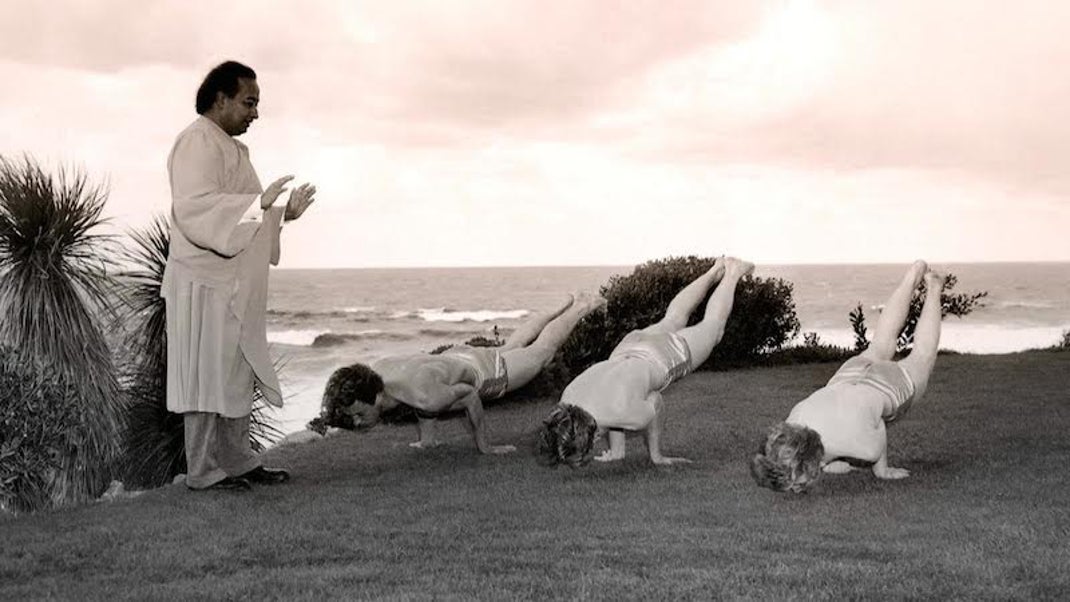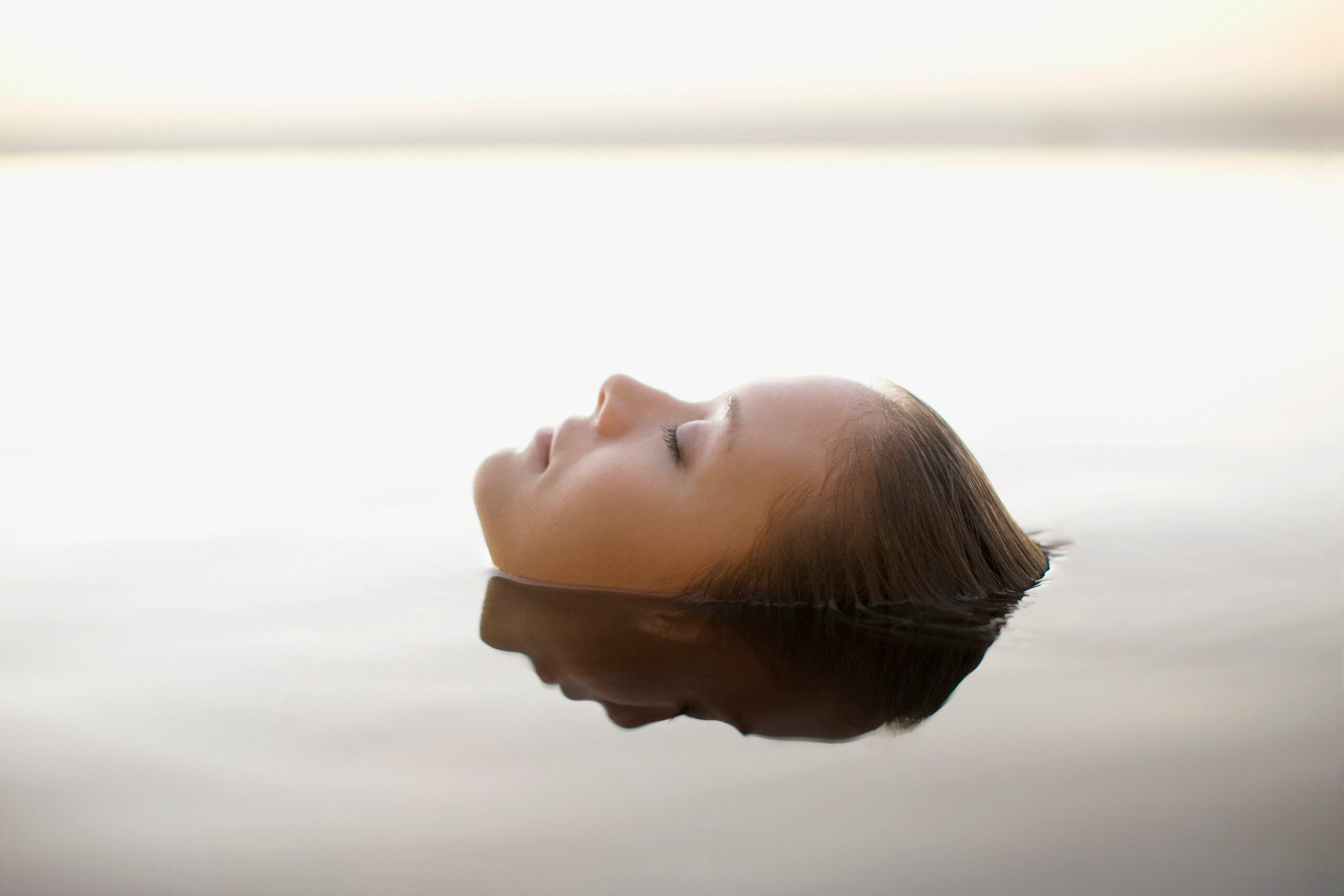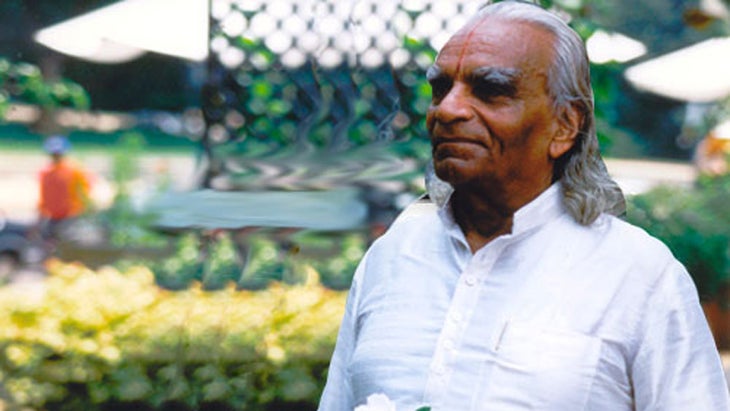Paramahansa Yogananda was a man before his time. Yogananda’s teachings are still important today because they offer ancient wisdom for living in the modern world. Yogananda is known for his spiritual and philosophical writings on topics such as meditation, yoga, and spiritual growth.
Yogananda founded the Self-Realization Fellowship organization to conduct classes worldwide and establish centers devoted to bringing education about Kriya Yoga to all people.
Yogis, meditators, and spiritual seekers make a movie date. Awake: The Life of Yogananda, began screening in October 2014 and as yoga documentaries go, this unconventional biopic is gripping, inspiring—dare we say, epic, even. In fact, Awake has already won three awards and received accolades from the yoga glitterati, including Ram Dass, Marianne Williamson, and Russell Simmons.
Co-directed by two yoga-practicing filmmakers (Oscar-nominee Paola di Florio and Sundance winner Lisa Leeman), Awake explores the life and teachings of Swami Paramahansa Yogananda, the author of the influential Autobiography of a Yogi and the founder of the Self-Realization Fellowship.
Featuring interviews with scientists, yoga teachers, and direct students of Yogananda, the film becomes a kind of who’s who of celebrities, including Deepak Chopra, Krishna Das, the late George Harrison, and Ravi Shankar.
Awake also captures intimate—and at times heartbreaking—moments of the guru’s life. Through slow-mo, sepia-toned reenactments, archival video footage, newspaper clippings, audio recordings, photos, and a narrative spun in Yogananda’s own words, the filmmakers hook you emotionally from the get-go.
Get a sneak peek of Awake in the following color stills and photographs from the film.
The Saint
 Above: Monks in Noida, India perform a puja to their guru. “This scene appears in a section of the film in which Yogananda as a young boy foresees his future, and is frightened by the great responsibility that a Guru must carry,” DiFlorio and Leeman explain.
Above: Monks in Noida, India perform a puja to their guru. “This scene appears in a section of the film in which Yogananda as a young boy foresees his future, and is frightened by the great responsibility that a Guru must carry,” DiFlorio and Leeman explain.
���It’s not easy to make a film about a saint,” DiFlorio and Leeman say. “We’re storytellers, and good narrative usually requires conflict, struggle, and a protagonist with human flaws. We searched for skeletons in Yogananda’s ‘closet,’ and while we found certain provocative allegations along the way, there was nothing to back them up. As we dug deeper into his life, however, we discovered that he faced major obstacles, many of which the public was unaware of…”
Despite being recognized as a ‘spiritual genius,’ the filmmakers said, Yogananda endured severe criticism and even racism in the Deep South, from people who felt threatened by him and his message. “Persecution, betrayals by students and close friends, and even financial ruin ensued,” they said. “But Yogananda rose like a phoenix through the ashes of his demise, not only to regain his own purpose in life but to inspire others to do the same through his example.” And there was their story.
The Renegade
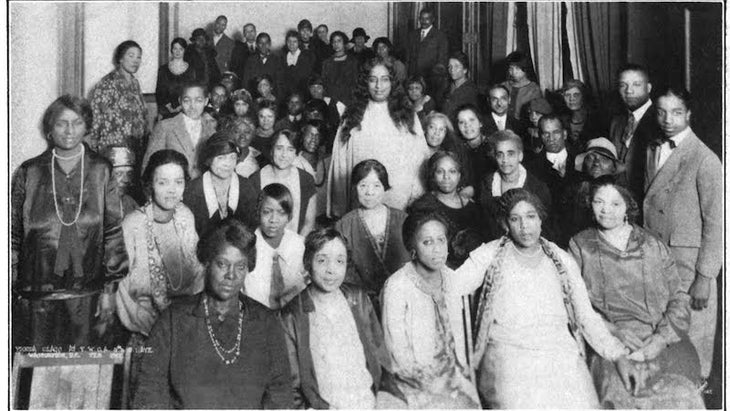
Quite the renegade of his day, Yogananda tackled social and political issues head-on.
For example, when he learned only white people would be allowed to attend his lectures in Washington, DC, in 1927, he says in the film, “I defied this and founded an Afro-American…center to teach my Negro brethren.” (Pictured above.)
And when it was still against US law to “mix races,” Yogananda publicly married an Indian man and an American woman, in an attempt to break down social and racial barriers. In doing so, he taught by example his ultimate belief that we are all one.
The Independent Thinker
 Yogananda was also a vocal supporter of Mahatma Gandhi. He lectured about him at Harvard. He visited Gandhi’s ashram in Wardha, India in 1935. And he even gave Gandhi—at his request—a lesson in Kriya Yoga, an ancient meditation method he learned from his own guru, Swami Sri Yuketswar, and taught to his students in India, Britain, and America.
Yogananda was also a vocal supporter of Mahatma Gandhi. He lectured about him at Harvard. He visited Gandhi’s ashram in Wardha, India in 1935. And he even gave Gandhi—at his request—a lesson in Kriya Yoga, an ancient meditation method he learned from his own guru, Swami Sri Yuketswar, and taught to his students in India, Britain, and America.
“We discovered that he was put on a government watch list and kept under surveillance by the FBI and the British authorities, who were probably concerned about the growing independence movement in India,” Leeman says.
The East-Meets-West Mystic
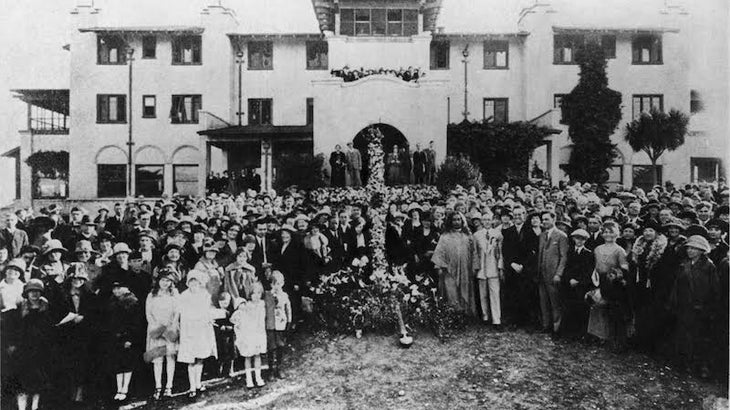 Above: Yogananda conducting the first Easter service at his headquarters of Mount Washington (a place he called “the spiritual White House”) in Los Angeles in 1925
Above: Yogananda conducting the first Easter service at his headquarters of Mount Washington (a place he called “the spiritual White House”) in Los Angeles in 1925
In an era of xenophobia and religious bigotry, Yogananda emphasized that all spiritual paths lead seekers to a profound experience of oneness. The guru’s love and respect for Jesus and his ability to embrace the teachings of Christianity and yoga at the same time made his teachings accessible to a Western audience.
“True Christianity has been lost and forgotten,” he booms in one of the film’s historical audio recordings. “And what the ancients taught in India has been lost and forgotten. Those ought to be revived as one highway to the infinite.”
The Sold-Out Speaker
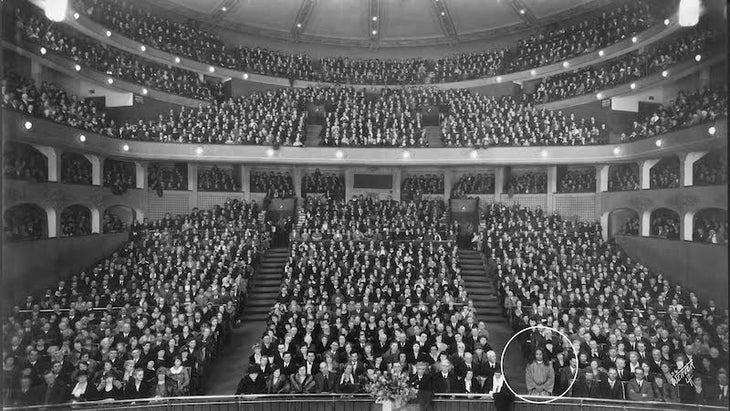 During his heyday in the West, Yogananda lectured to full houses across the country on topics such as yoga and meditation; the oneness of Hinduism and Christianity; how to cultivate willpower; how to be happy; and even how to attract a soulmate.
During his heyday in the West, Yogananda lectured to full houses across the country on topics such as yoga and meditation; the oneness of Hinduism and Christianity; how to cultivate willpower; how to be happy; and even how to attract a soulmate.
“In Yogananda’s teachings, he talks about reversing the searchlights of our senses, which are always pointed outwards toward the world around us,” DiFlorio says. “He teaches us to turn the searchlights back on ourselves to go within. When we do so, we gain access to a new realm of information—an intuitive realm that is the key to any creative process.”
The Acclaimed Author
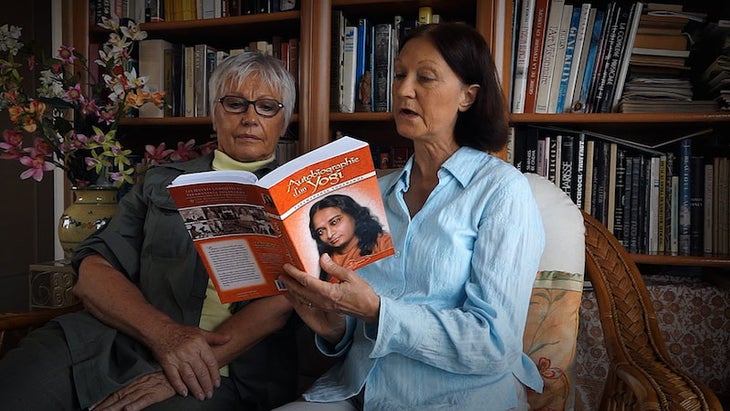
“We asked participants from over 30 countries to contribute footage for the third act of the film, in an attempt to demonstrate Yogananda’s worldwide legacy,” the filmmakers told YogaJournal.com. “Here, devotees in Paris read aloud to each other from Autobiography of a Yogi.” Awake explores how the book, available in dozens of languages, influenced celebrities and thought leaders, ranging from Steve Jobs to George Harrison.
The Teacher
 Yogananda taught his student’s hatha yoga as a way to prepare the body and mind for meditation. He developed a system of “energization exercises,” which he said “charge the body with the life current of the universe” and “keep the diseases from settling.” In the photo above from the SRF archives, he teaches a yoga class at his Encinitas, California hermitage, overlooking the Pacific Ocean.
Yogananda taught his student’s hatha yoga as a way to prepare the body and mind for meditation. He developed a system of “energization exercises,” which he said “charge the body with the life current of the universe” and “keep the diseases from settling.” In the photo above from the SRF archives, he teaches a yoga class at his Encinitas, California hermitage, overlooking the Pacific Ocean.
He encouraged his students to use their bodies as a living laboratory, in which they could conduct experiments and observe the results firsthand.
“Don’t take my word for anything,” he says in the film. “Apply these techniques and find out for yourselves.”
The Divine
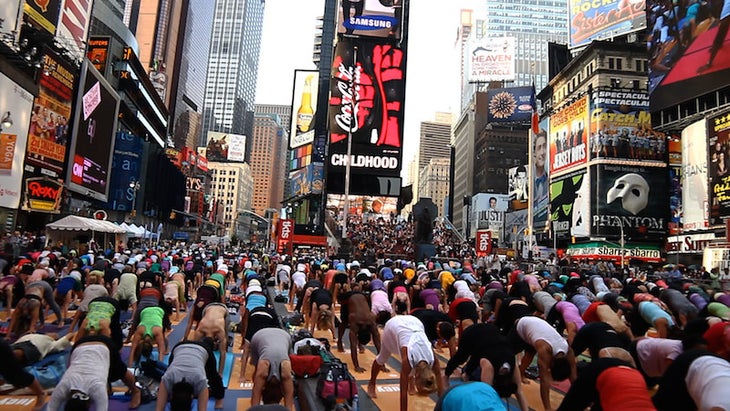
“I think yoga is in the midst of maturing in this country,” Leeman says. “Practitioners and teachers are shifting from postural-only hatha yoga to a wider palette of yogic practices. More people are recognizing that yoga is a set of tools that is available to people of all faiths, and also to people of no faith, to cultivate peace and connection to life around them, and to their our own inner selves.”
The film explains that yoga at its core is a meditative practice, designed to expand one’s consciousness. And thanks to the foundation Yogananda laid here nearly a century ago, modern American yogis have a rich tradition of spirituality available to them.
“With this film, we hope to broaden the definition of what ‘yoga’ means in the West, beyond asana practice,” DiFlorio explains. “It is about awakening to our true nature, to who we really are. Through Yogananda’s story, the film invites us to remember and recognize divinity, or oneness—not only within ourselves but within everyone and everything around us. The practice of yoga is an eight-fold path, and meditation leads us to this experience of oneness.”
The Guru
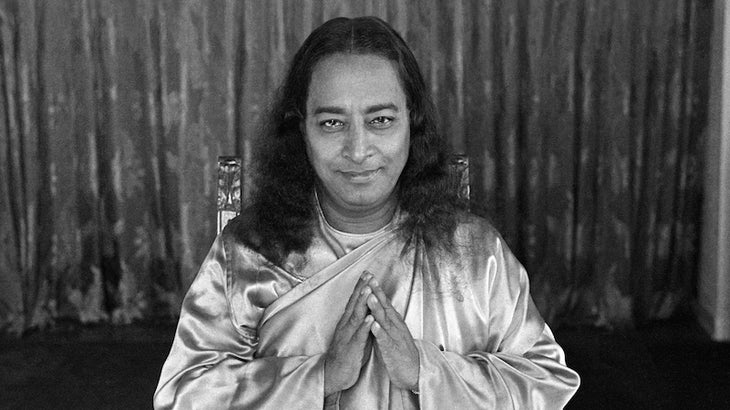
Above: Yogananda in 1947 at his cliff-top retreat in Encinitas, California, where he wrote his iconic autobiography.
“Yogananda broke down his teachings for us in volumes of step-by-step lessons on how to live,” DiFlorio says. “They lead us to a fundamental truth: We are not the body. We are ‘the ocean of consciousness,’ as he would say. Meditation is about remembering that and experiencing it over and over again. I can’t think of a better way to live.
Conclusion:
Paramahansa Yogananda was a man before his time, and his teachings have continued to influence people around the world for generations. Through the film Awake, we are able to explore Yogananda’s life and teachings in more depth and see how they can be applied to our own lives.
Yogananda’s legacy is one of awakening and remembering our true nature, which is divine. Thanks to him, modern American yogis have a rich tradition of spirituality available to them. may we all continue to benefit from his wisdom for years to come!
